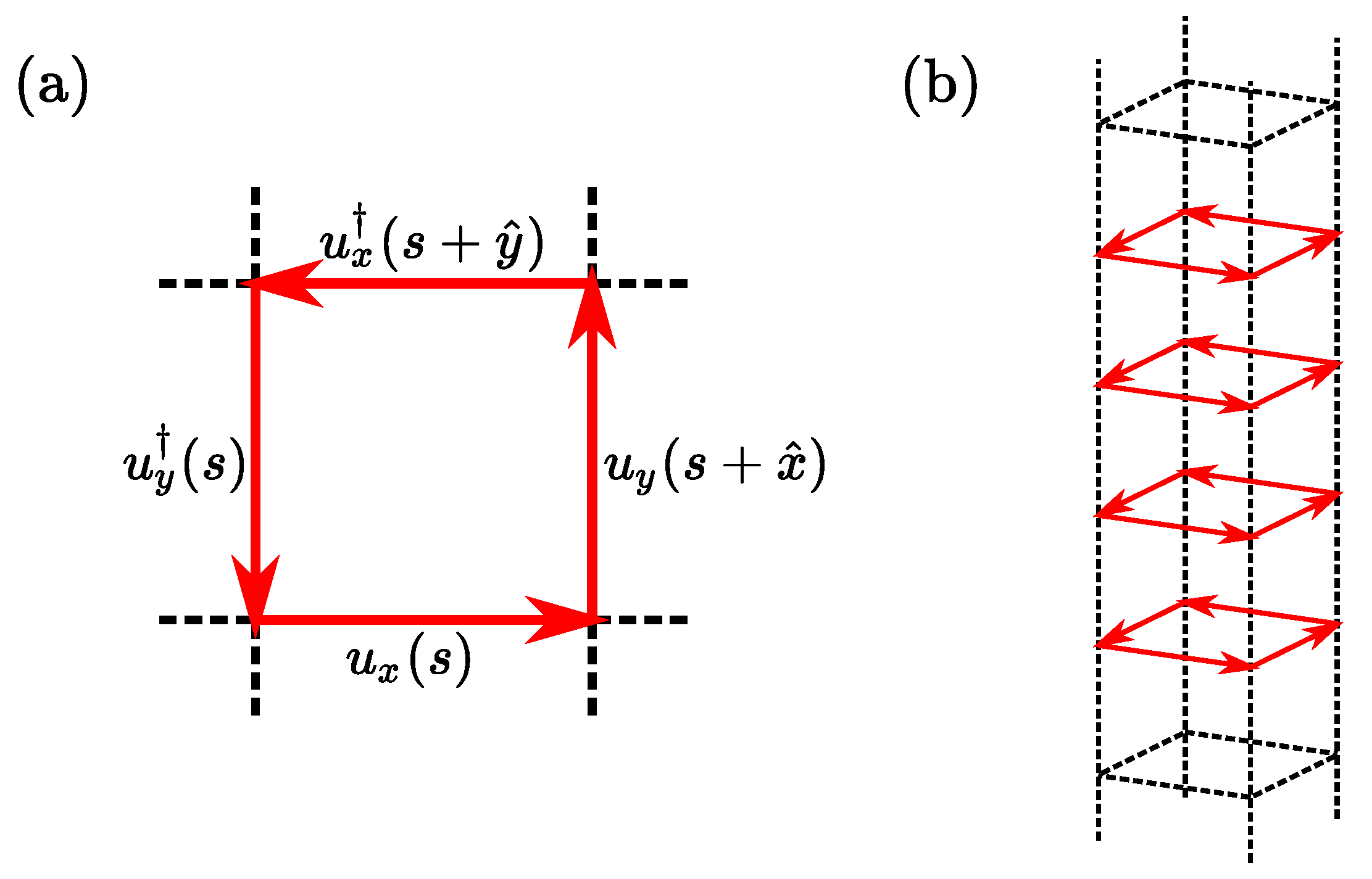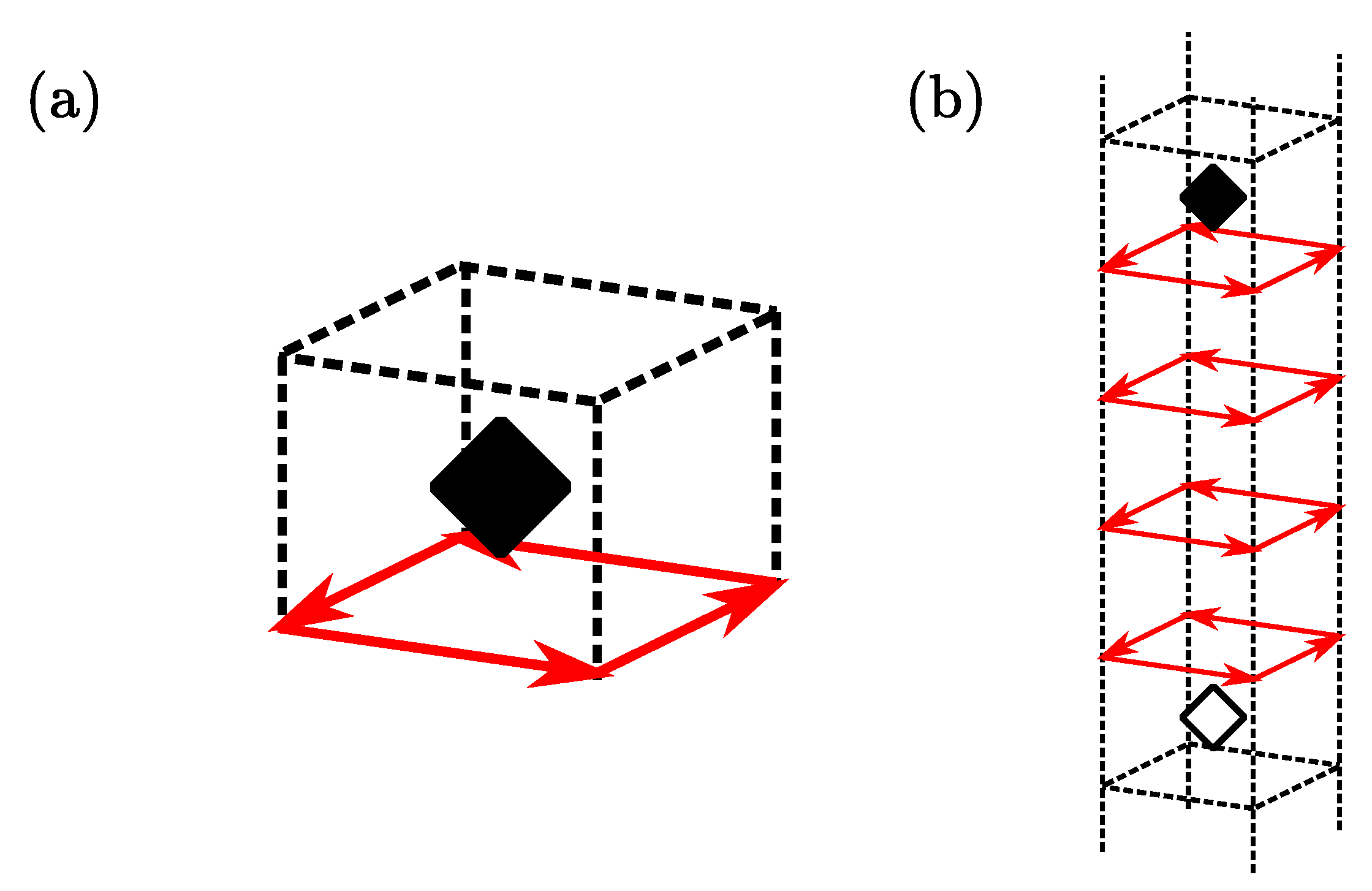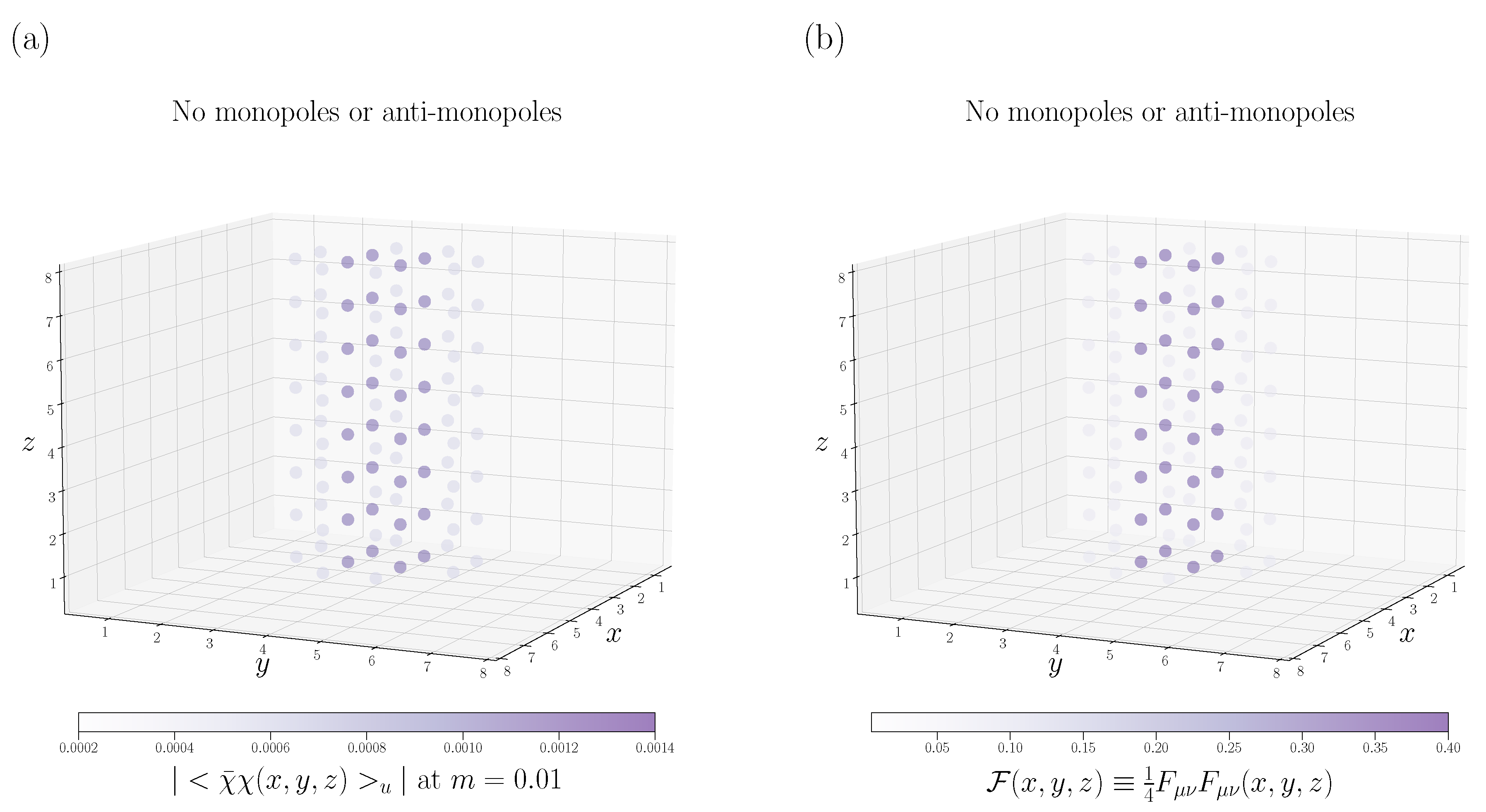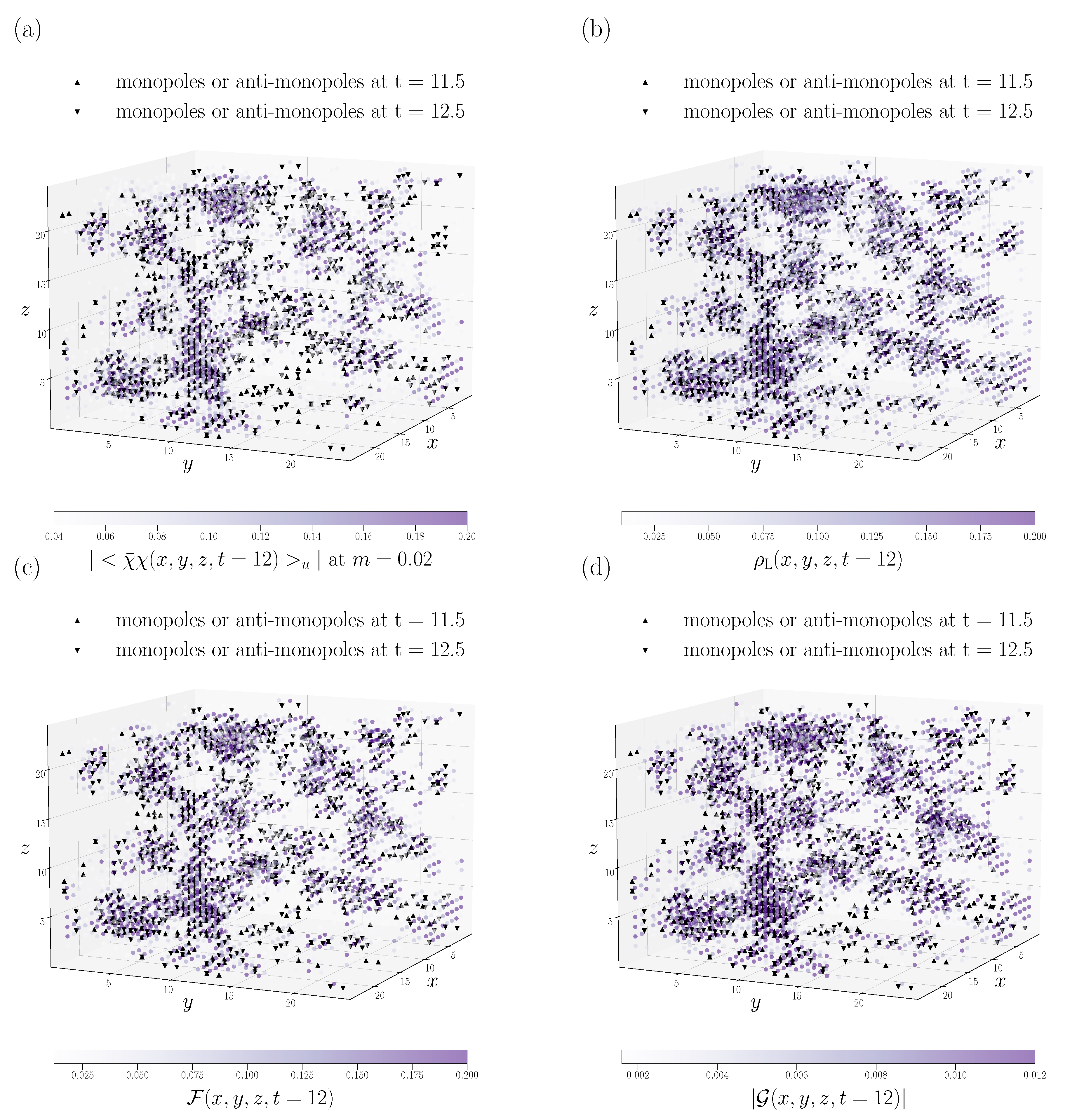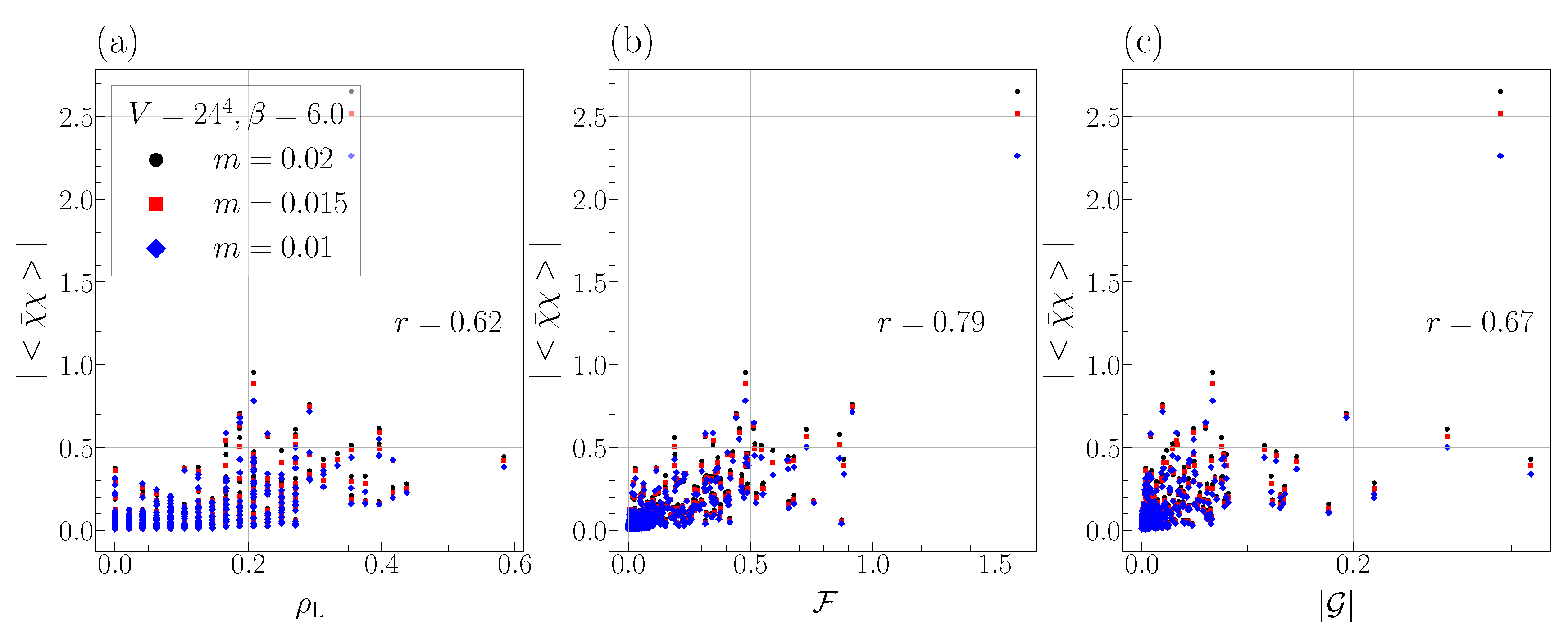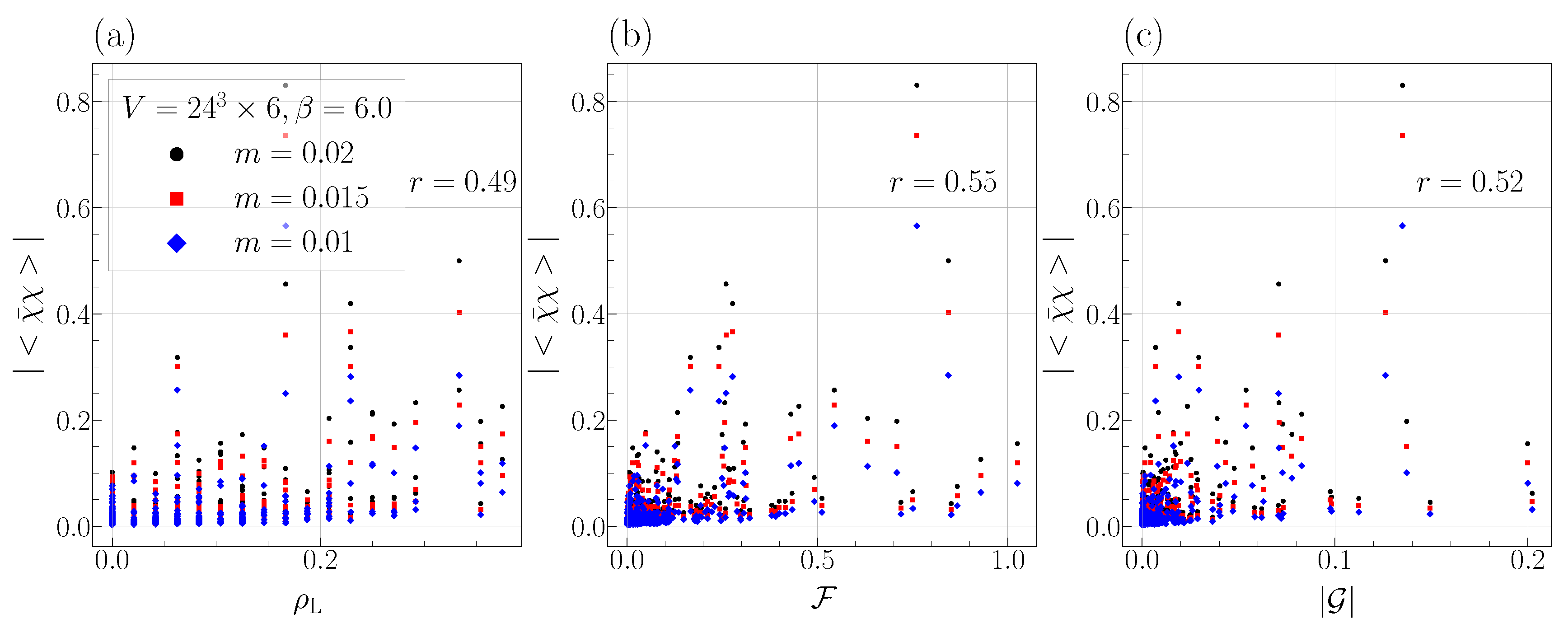1. Introduction
Quantum chromodynamics (QCD) is an SU(
) gauge theory to describe the strong interaction, and has presented many interesting subjects full of variety and difficult problems in physics. Actually, in spite of the simple form of the QCD action, this miracle theory creates hundreds of hadrons and leads to various interesting non-perturbative phenomena, such as color confinement and dynamical chiral-symmetry breaking [
1].
This magic is due to the strong coupling of QCD in the low-energy region, and this strong-coupling nature drastically changes the vacuum structure itself. Therefore, a perturbative technique is no more workable and analytical treatment of QCD is fairly difficult in the strong-coupling region. As a reliable standard technique, lattice QCD Monte Carlo simulations have been applied to analyze non-perturbative QCD [
2,
3].
Among the non-perturbative properties of QCD, spontaneous chiral-symmetry breaking is particularly important in our real world. Indeed, chiral symmetry breaking drastically influences the vacuum structure and gives a non-trivial vacuum expectation value of the chiral condensate
, which plays the role of an order parameter. Additionally, it is considered that chiral symmetry breaking leads to dynamical quark-mass generation [
1,
4], and creates most of the matter mass of our Universe, apart from the dark matter, because only small masses of u, d, current quarks, and electrons are Higgs-origin in atoms [
5] and their contribution to the nucleon mass is estimated to be small [
6]. In addition, chiral symmetry breaking inevitably accompanies light pions of the Nambu–Goldstone bosons, and their small mass gives range of the nuclear force.
In non-perturbative QCD, color confinement is also one of the most important phenomena in physics, and presents an extremely difficult mathematical problem. Experiments for hadron spectra and lattice QCD studies for various inter-quark potentials [
7,
8,
9,
10] show that the quark confining force is basically characterized by a universal physical quantity of the string tension
0.89 GeV/fm. This universal string tension is physically explained by one-dimensional squeezing of the color electric flux, i.e., the color flux-tube formation in hadrons, as is also indicated by lattice QCD for both mesons [
3] and baryons [
11]. As for the relation between color confinement and chiral symmetry breaking, it is not yet clarified directly from QCD. Although almost coincidence between deconfinement and chiral-restoration temperatures [
12] suggests their close correlation, a lattice QCD analysis using the Dirac-mode expansion based on the Banks–Casher relation [
13] indicates some independence of these phenomena in QCD [
14,
15].
For the quark confinement mechanism, Nambu [
16], ’t Hooft [
17], and Mandelstam [
18] proposed the dual superconductivity scenario, paying attention to analogy with the Abrikosov vortex in the superconductivity, where Cooper-pair condensation leads to the Meissner effect, and the magnetic flux is excluded or squeezed like a one-dimensional tube as the Abrikosov vortex. If the QCD vacuum can be regarded as the dual version of the superconductor, the electric-type color flux is squeezed between (anti)quarks in hadrons, and quark confinement can be physically explained by the dual Meissner effect. Because of the electromagnetic duality, the dual Meissner effect inevitably needs condensation of magnetic objects, i.e., color magnetic monopoles, which correspond to the dual version of the electric Cooper-pair bosonic field.
In the dual-superconductor picture for the QCD vacuum, however, there are two large gaps with QCD.
- 1.
Although QCD is a non-Abelian gauge theory, the dual-superconductor picture is based on an Abelian gauge theory subject to the Maxwell-type equations including magnetic currents, where electromagnetic duality is manifest;
- 2.
Although QCD includes only color electric variables, i.e., quarks and gluons, as the elementary degrees of freedom, the dual-superconductor picture requires condensation of color magnetic monopoles as a key concept.
Historically, to bridge between QCD and the dual-superconductivity, ’t Hooft proposed Abelian gauge fixing [
19], partial gauge fixing which only remains Abelian gauge degrees of freedom in QCD. By Abelian gauge fixing, QCD reduces into an Abelian gauge theory, where off-diagonal gluons behave as charged matter fields similar to
in the Weinberg–Salam model and give the color electric current
in terms of the residual Abelian gauge symmetry. As a remarkable fact in the Abelian gauge, color-magnetic monopoles appear as topological objects corresponding to the non-trivial homotopy group
in a similar manner to appearance of ’t Hooft–Polyakov monopoles [
20] in the SU(2) non-Abelian Higgs theory. Thus, in the Abelian gauge, QCD is reduced into an Abelian gauge theory, including both electric current
and magnetic current
, which is expected to give a theoretical basis of the dual-superconductor picture for the confinement mechanism, although off-diagonal gluons remain as charged matter fields.
From the viewpoint of Abelianzation of QCD, the maximally Abelian (MA) gauge [
21] is an interesting special Abelian gauge. In the MA gauge, off-diagonal gluons have a large effective mass of about 1 GeV in both SU(2) and SU(3) lattice QCD [
22,
23,
24], so that off-diagonal gluons become infrared inactive, and only the Abelian gluon is relevant at distances larger than about 0.2 fm. Additionally, monopole condensation is suggested from appearance of long entangled monopole worldlines [
21,
25] and the magnetic screening in lattice QCD [
26,
27].
In this way, by taking the MA gauge, the QCD vacuum can be regarded as an Abelian dual superconductor at a large scale, and color magnetic monopoles seem to capture essence of non-perturbative QCD. Note, however, that, even without gauge fixing, there is an evidence of monopole condensation in non-Abelian gauge theories [
27], and, therefore, it might be possible to define infrared-relevant monopoles in QCD and to construct the dual superconductor system in more general manner. In fact, MA gauge fixing gives a concrete way to extract infrared-relevant Abelian gauge manifold and monopoles from QCD.
In the context of the dual superconductor picture, close correlation between monopoles and chiral symmetry breaking was pointed out in the dual Ginzburg–Landau theory [
28], in SU(2) lattice QCD in the MA gauge [
29,
30], and in SU(3) lattice QCD [
31,
32]. Since most of the pioneering lattice studies were done in SU(2) QCD or on a small lattice as
, we recently investigated SU(3) QCD with a large volume, and find a clear correlation between monopoles and the chiral condensate in SU(3) lattice QCD in the MA gauge [
33].
In this paper, as a continuation of Ref. [
33], we proceed the lattice works for the relation between chiral symmetry breaking and color magnetic objects including monopoles. In particular, as a new point of this paper, we quantitatively study correlation of the local chiral condensate with color magnetic fields using the lattice gauge theory.
The organization of this paper is as follows. In
Section 2, we review the MA gauge and Abelianization of QCD in SU(3) lattice formalism. In
Section 3, we prepare magnetic objects in Abelian projected QCD. In
Section 4, we consider the local chiral condensate and chiral symmetry breaking in Abelian gauge systems. In
Section 5, we present idealized Abelian gauge systems of a static monopole–antimonopole pair on a lattice, and investigate the relation of the local chiral condensate with the magnetic objects. In
Section 6, we perform SU(3) lattice QCD Monte Carlo calculations and study the relation among monopoles, magnetic fields, and the local chiral condensate in Abelian projected QCD in the MA gauge.
Section 7 is devoted for summary and conclusion.
2. Maximally Abelian Gauge and Abelianization of QCD
To begin with, we briefly review the lattice formalism for maximally Abelian (MA) gauge fixing and Abelianization in QCD.
Continuum QCD is described with the quark field
, the gluon field
and the QCD gauge coupling
g. In SU(
) lattice QCD [
3], the gluon field is described as the SU(
) link variable
on four-dimensional Euclidean lattices with the spacing
a and the volume
.
Using the Cartan subalgebra
in SU(3), MA gauge fixing is defined so as to maximize
by the SU(3) gauge transformation, and, therefore, this gauge fixing strongly suppresses all the off-diagonal fluctuation of the SU(3) gauge field. In the MA gauge, the SU(3) gauge group is partially fixed remaining its maximal torus subgroup
with the global Weyl (color permutation) symmetry [
34], and QCD is reduced to an Abelian gauge theory.
From the SU(3) link variable
in the MA gauge, we extract the Abelian link variable
by maximizing the overlap
Note that the distance between
and
becomes the smallest in the SU(3) manifold, and there is a constraint
reflecting the uni-determinant of
. Here,
(
i = 1, 2, 3) is taken to be the principal value of
.
The Abelian projection is defined by the simple replacement of the SU(3) link variable
by the Abelian link variable
for each gauge configuration, that is,
for QCD operators. Abelian projected QCD is thus extracted from SU(3) QCD. The case of
is called “Abelian dominance” for the operator
O [
35].
As a remarkable fact, Abelian dominance of quark confinement is shown in both SU(2) [
36] and SU(3) lattice QCD [
37,
38,
39]. Additionally, Abelian dominance of chiral symmetry breaking is observed in SU(2) [
29,
30,
31] and SU(3) lattice QCD [
33].
5. Abelian Gauge System with a Static Monopole–Antimonopole Pair on a Lattice
In the QCD vacuum, complicated monopole world-lines generally emerge in the MA gauge [
21,
25], and, therefore, it is difficult to clarify the primary correlation with the chiral condensate among the magnetic objects, such as monopoles,
and
.
In this section, to seek for the primary correlation with the chiral condensate, we create idealized Abelian gauge system with a monopole–antimonopole pair on a lattice, and investigate the relation among the local chiral condensate, monoples, and magnetic fields. Additionally, we consider a magnetic flux system without monopoles.
For simplicity, we here consider U(1) lattice gauge systems described by U(1) link variables
and quasi-massless Dirac fermions coupled to U(1) gauge fields with the coupling
.
5.1. Static Monopole–Antimonopole Pair Systems
To begin with, we deal with an idealized Abelian gauge system of a static monopole–antimonopole pair on a periodic lattice of the four-dimensional Euclidean space-time.
In the three-dimensional space
, let us consider a static monopole–antimonopole pair with the distance of
l in
z-direction. To realize such a lattice gauge system, we set the Abelian link-variable
to be
otherwise
.
Figure 1 shows the building-block plaquette to realize a static monopole–antimonopole pair on the lattice. Here, only the red link-variables take a non-trivial value of
i.
As for the phase variable
, which corresponds to the Abelian gluon, one finds
otherwise
. For the all-red plaquette with
and
, one gets
which leads to the Dirac string of
and zero field strength
, because of the definition of the field strength
and the Dirac string
,
Thus, the all-red plaquette induces the singular Dirac string at its center on the dual lattice. In fact, for the idealized system in
Figure 1b, a Dirac string appears inside the all-red plaquette.
At the terminal of the Dirac string, a monopole or an anti-monopole appears on the dual lattice, as shown in
Figure 2. Actually, the three-dimensional spatial cube including only one all-red plaquette has a static (anti)monopole at its center (on the dual lattice), because only one
has non-zero value of
among the six independent plaquettes composing the cube,
Thus, this idealized system includes a static monopole at
and a static anti-monopole at
in spatial
.
This monopole and anti-monopole system has also physical magnetic flux around the line segment connecting the monopole pair. In fact, a physical magnetic field is created in the neighboring plaquette
of the all-red plaquette in
Figure 1. In this idealized system, only the plaquette
including one red link takes a non-trivial value as
otherwise
. Note here that, by gauge transformation, the location of the Dirac string is generally changed, but the physical field strength is never changed.
Figure 3 shows the local chiral condensate
and the magnetic quantity
for
in the three dimensional space
. In this demonstration, the quark mass is taken to be
in the lattice unit.
For this idealized static system, there actually appears a magnetic field , i.e., non-zero flux of , in space between the monopole and the anti-monopole, and the local chiral condensate takes a significant value in the vicinity of the magnetic field. In contrast, one finds everywhere, since only spatial plaquettes take a non-trivial value and . Thus, in this system, it is likely that the magnetic field stemming from monopoles has the primary correlation with the local chiral condensate.
5.2. Static Magnetic Flux System
Next, let us investigate a static magnetic flux system without monopoles. Owing to the spatial periodicity, the special case of in the static monopole–antimonopole system has no (anti)monopoles, because of the magnetic-charge cancellation. In this special case of , there only exists a physical static magnetic flux along z-direction.
Figure 4 shows the local chiral condensate
and the magnetic quantity
for
in spatial
, taking the quark mass of
in the lattice unit.
Again, the local chiral condensate takes a significant value in the vicinity of the magnetic field , i.e., non-zero flux of , even without (anti)monopoles. Note also that this system has everywhere, because of . Therefore, in this idealized system, we conclude that the magnetic field or has the primary correlation with the local chiral condensate.
6. Lattice QCD Study for Local Chiral Condensate, Monopoles, and Magnetic Fields
In our previous study with lattice QCD, we observed a strong correlation between the local chiral condensate and monopoles in Abelian projected QCD [
33]. As a possible reason of this correlation, we conjectured that the strong magnetic field around monopoles is responsible to chiral symmetry breaking in QCD, similarly to the magnetic catalysis [
46,
47,
48,
49].
In this section, using lattice QCD Monte Carlo simulations, we investigate the relation among the local chiral condensate, monopoles, and magnetic fields in Abelian projected QCD. In this paper, the SU(3) lattice QCD simulation is performed using the standard plaquette action at the quenched level. In each space-time direction, we impose the periodic boundary condition for link variables, and the anti-periodic boundary condition for quarks in order to describe also thermal QCD.
For the numerical Monte Carlo calculation, we basically adopt the lattice parameter of
and the size
. The lattice spacing
0.1 fm is obtained from the string tension
GeV/fm [
37]. Additionally, we adopt
and
for the high-temperature deconfined phase at
330 MeV above the critical temperature.
Using the pseudo-heat-bath algorithm, we generate 100 and 200 gauge configurations for
and
, respectively. All the gauge configurations are taken every 500 sweeps after thermalization of 5000 sweeps. MA gauge fixing is performed with the stopping criterion that the deviation
becomes smaller than
in 100 iterations. For the calculation of the local chiral condensate, we use the quark propagator of the KS fermion with the quark mass of
in the lattice unit, Here, the quark mass is taken to be finite, since the chiral and continuum limits do not commute for the KS fermion at the quenched level [
45]. The jackknife method is used for statistical error estimates.
For each lattice gauge configuration of Abelian projected QCD in the MA gauge, we calculate the local monopole density
, the local chiral condensate, and the Lorentz invariants
and
, defined in
Section 3.
6.1. Distribution Similarity between Local Chiral Condensate and Magnetic Variables
To begin with, we pick up a gauge configuration generated in lattice QCD on at , and investigate correlation between the local chiral condensate and magnetic variables.
Figure 5 shows the local chiral condensate
with the quark mass of
, the local monopole density
, and the Lorentz invariants
and
, respectively, as well as the monopole location in the space
at a time slice, for a typical gauge configuration of Abelian projected QCD.
From
Figure 5a, one finds that the local chiral condensate tends to take a large value near the monopole location [
33]. Since monopoles appear on the dual lattice, we show the local monopole density
, as the average on closest dual sites. Of course,
takes a large value near the monopole. The distribution of the the local monopole density resembles that of the local chiral condensate, as was pointed out in Ref. [
33].
Figure 5c,d show the Lorentz invariants
and
, respectively. As a new result in this paper, we find that the distributions of
and
also resemble that of the local chiral condensate.
The close relation of monopoles with and might be understood, since the field strength tensor relates to monopoles as . Roughly speaking, the monopole can be a kind of source of and . In contrast, their similarity with the local chiral condensate is fairly non-trivial.
In any case, we find clear correlation of distribution similarity among the local chiral condensate, the local monopole density, and the Lorentz invariants and in Abelian projected QCD in the MA gauge.
6.2. Correlation Coefficients between Local Chiral Condensate and Magnetic Variables
In this subsection, we quantify the similarity between the local chiral condensate
and magnetic variables, i.e.,
,
and
, defined in
Section 3. To this end, we use all the generated 100 gauge configurations in lattice QCD on
at
, and calculate the local chiral condensate at
distant space-time points for each gauge configuration, resulting 1600 data points at each quark mass.
Figure 6 shows the scatter plot between the local chiral condensate
and magnetic variables, i.e., the local monopole density
, Lorentz invariants
and
, respectively, using 100 gauge configurations of Abelian projected QCD in the MA gauge, with the quark mass of
in the lattice unit. In
Figure 6, positive correlation is qualitatively found between the local chiral condensate and the magnetic variables,
,
and
, respectively.
Next, we consider a quantitative analysis using correlation coefficients between the local chiral condensate and the magnetic variables, as a statistical indicator of correlation. In general, for arbitrary two statistical ensembles
and
, their correlation coefficient
r is defined as
using the average notation
and the standard deviation
and
. Here,
means perfect positive linear correlation, and
indicates strong positive linear correlation.
We measure correlation coefficients between the local chiral condensate
and three magnetic variables,
,
and
, at various exponent
, using 100 gauge configurations of Abelian projected QCD in SU(3) lattice QCD at
on
, for the quark mass
in the lattice unit.
Table 1 shows the result for the correlation coefficients.
Quantitatively, the magnetic quantity has the strongest correlation with the chiral condensate rather than and . As a conclusion of this paper, we find a strong positive correlation of between the local chiral condensate and the magnetic quantity in the confined vacuum of Abelian projected QCD.
6.3. High-Temperature Deconfined Phase
Finally, we also investigate a high-temperature deconfined phase in lattice QCD on at , where the temperature is 330 MeV above the critical temperature. We generate 200 gauge configurations, and calculate the local chiral condensate at distant space points at a time slice for each gauge configuration, resulting 1600 data points at each quark mass.
Figure 7 shows the scatter plot between the local chiral condensate
and magnetic variables, i.e., the local monopole density
, and Lorentz invariants
and
, respectively, using 200 gauge configurations of Abelian projected QCD in the MA gauge, with the quark mass of
in the lattice unit.
We show in
Table 2 correlation coefficients between the local chiral condensate
and three magnetic variables,
,
and
, at various exponent
, using 200 gauge configurations of Abelian projected QCD in SU(3) lattice QCD at
on
, for the quark mass
in the lattice unit.
From
Figure 7 and
Table 2, all the correlations between the local chiral condensate and the three magnetic variables,
,
and
, become weaker in the deconfined phase, where the chiral condensate itself goes to zero in the chiral limit.
7. Summary and Conclusions
We have studied the relation among the local chiral condensate, monopoles, and magnetic fields, using the lattice gauge theory, as a continuation of Ref. [
33].
First, we have created idealized Abelian gauge systems of (1) a static monopole–antimonopole pair, and (2) a magnetic flux without monopoles, on a four-dimensional Euclidean lattice. In these systems, we have calculated the local chiral condensate on quasi-massless fermions coupled to the Abelian gauge field, and have found that the chiral condensate is localized in the vicinity of the magnetic field.
Second, performing SU(3) lattice QCD Monte Carlo simulations, we have investigated Abelian projected QCD in the maximally Abelian gauge, and have found clear correlation of distribution similarity among the local chiral condensate, color monopoles, and color magnetic fields in the Abelianized gauge configuration.
As a statistical indicator, we have measured the correlation coefficient r, and have found a strong positive correlation of between the local chiral condensate and the Euclidean color-magnetic quantity .
We have also examined the local correlation in the deconfined phase of thermal QCD, and have found that the correlation between the local chiral condensate and magnetic variables becomes weaker.
Thus, in this paper, we have observed a strong correlation between the local chiral condensate and magnetic fields in both idealized Abelian gauge systems and Abelian projected QCD. From these results, we conjecture that the chiral condensate is locally enhanced by the strong color-magnetic field around the monopoles in Abelian projected QCD, like magnetic catalysis.
Note, however, that this correlation does not necessarily mean that chiral symmetry breaking is caused by the non-uniform magnetic field. To realize spontaneous chiral-symmetry breaking, as was discussed in
Section 4.2, we need some zero mode in the denominator of
I in the chiral limit. In the context of the dual superconductor picture, this might be realized by condensation of monopoles, as was suggested in the dual Ginzburg-Landau theory [
28].
To conclude, once chiral symmetry is spontaneously broken, the local chiral condensate is expected to have a strong correlation with the color magnetic field.
